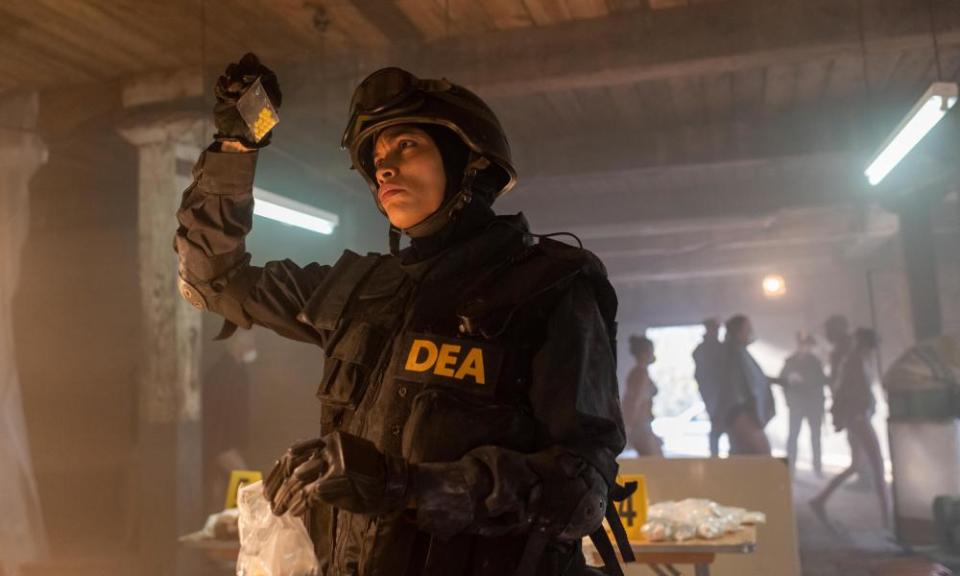Dopesick review – the heinous truth behind America’s opioid emergency

Watching Dopesick (Disney+) is, appropriately enough, like being given a series of bitter pills to swallow. The eight-part drama – based on the non-fiction book of the same name by Beth Macy – examines the dreadful causes and effects of the opioid crisis unleashed in large part on the United States by Purdue Pharma, and its “non-addictive” painkiller OxyContin. Fictionalised in the details but telling a factually correct story, it is a powerful illustration of the power of people unconstrained by financial or moral limits, and the suffering induced by corporate greed unfettered by an overwhelmed and under-resourced regulatory and legal system.
Related: ‘A story people need to know’: behind a shocking TV series about the opioid crisis
The miniseries comprises three strands. The first is the tale of Dr Samuel Finnix, played with commendable unshowiness by Michael Keaton. Finnix is a devoted doctor in a tiny Appalachian mining town, targeted by Purdue as part of its mission to overcome doctors’ reticence to prescribe opioids for long-term use because of their well-documented addictive qualities. He is persuaded by eager young Purdue rep Billy Cutler (Will Poulter) to start some patients on the new drug. An early prescription goes to Betsy (Kaitlyn Dever), who works in the mines alongside her father, and suffers a back injury. She can’t afford to miss work, especially as she and her girlfriend are saving to start a new life in a more welcoming town. As she becomes dependent on OxyContin, Betsy’s story combines the impoverished circumstances, bad luck and sense of hope that turned such towns into ground zero for an epidemic so explosive it would virtually remake the country. Almost the first words Finnix speaks on screen are at a hearing in 2005, speaking about his patients: “I can’t believe how many of them are dead now.”
The second strand concerns the legal efforts to pursue Purdue and its owners, the Sackler family. Peter Sarsgaard and John Hoogenakker play two real-life figures – assistant US attorneys Rick Mountcastle and Randy Ramseyer respectively – who eventually brought a suit against the company. It is largely through them and the composite character of Drug Enforcement Administration (DEA) deputy director Bridget Meyer (Rosario Dawson) that we come to understand the dangerously porous nature of the boundary between public and private work – allowing, for example, the Food and Drug Administration (FDA) regulators to leave government employment to work for the people they had previously been regulating. We also see how Purdue’s marketing strategy changed attitudes towards pain and pain management among both the general public and the medical profession, and appreciate the massaging and outright abrogation of truth and responsibility required to create a market for OxyContin in the first place.

The third strand focuses on the Sacklers – specifically Richard (Michael Stuhlbarg)– the prime mover behind making OxyContin palatable for wider use in order to supersede a lucrative patent held by the company, which is about to run out. He takes a lesson from his Uncle Arthur’s playbook, who was commissioned by 1960s pharma giant Roche to develop a marketing campaign for their anti-anxiety medication Valium, despite its effects being virtually the same as another of their products, Librium. Arthur invented the idea of “psychic tension” as a Valium-specific condition, and the rest is diazepam-coshed history. In Richard’s case, the opioid oxycodone is given a slow-release coating that will supposedly give 12 hours of relief without a high, and consequently avoid addiction and abuse, and Americans are vouchsafed a vision of a pain-free world. And why not! It must be OK because the FDA has labelled it safe for moderate pain use. The chief that did so would a year later go to work at Purdue for $400,000 a year. When the effects prove not to last 12 hours, patients’ discomfort is rebranded “breakthrough pain” and the solution touted by the makers is to double the dose.
There is almost too much going on in Dopesick. The strands stretch and spread rather than twining tightly round each other, and its structure – jumping forwards and backwards across the different timelines – dissipates both narrative sense and momentum. The result is a series that is far more chaotic than it needs to be; the more familiar you already are with the Sackler story and the opioid crisis, the more you will get out of it, which is not the dramatic ideal. But the main points and the outrage are clear. It is perhaps best experienced as a companion piece to the excoriating documentary on the same subject, The Crime of the Century. Perhaps, just this once, we should welcome a double dose of medicine.

 Yahoo News
Yahoo News 
